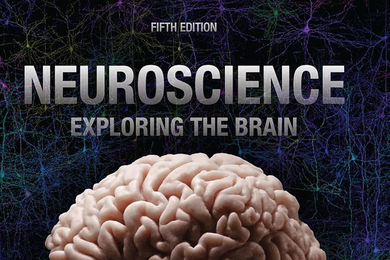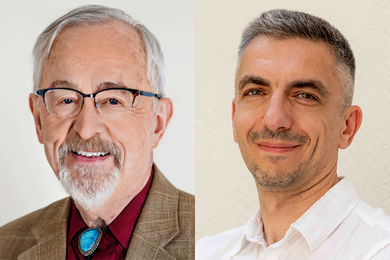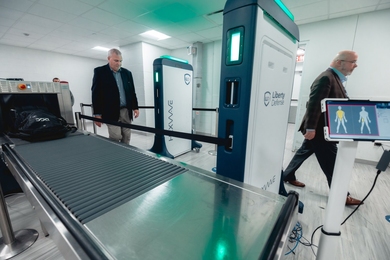The four days of festivities celebrating the inauguration of President L. Rafael Reif got off to an information-intensive start this morning, with a symposium at Kresge Auditorium called “Infinite Innovation.” In less than three hours, 26 MIT researchers gave presentations on their most innovative recent work, in sessions titled “Faculty and Research Innovation,” “Student Innovation,” and “Visions of the Future.”
Although the 14 faculty speakers in the first session covered a wide range of topics, one theme that emerged was the importance of interdisciplinary collaboration.
Fiona Murray, the David Sarnoff Professor of Management of Technology at the MIT Sloan School of Management, established the context for several other presentations when she described her research as debunking the “mythology of innovation” in which pioneering work is done by a “lone genius”: “Think of Newton discovering gravity in a small English village.” In her own work, Murray said, she’s found that the most productive teams tend to be those that are open to sharing ideas across disciplinary and institutional boundaries — even in contests where millions of dollars are at stake, and secrecy might seem to afford a competitive advantage.
Several other speakers described their own barrier-breaking research. Angela Belcher, the W. M. Keck Professor of Energy, explained how her lab genetically engineers organisms to interact with nonbiological molecules, so that they can aid in the assembly of batteries or solar panels, or the conversion of methane gas into ethylene.
Where Belcher imports biology into engineering, Christopher Voigt, an associate professor of biological engineering, imports electrical engineering into biology. He and his students describe the biological interactions that lead to protein production as if they were electrical circuits, and they’ve developed programming tools that allow biologists to recombine these circuits, re-engineering cells to perform wholly new functions.
Yang Shao-Horn, the Gail E. Kendall Associate Professor of Mechanical Engineering, said that her work is motivated by the vital question of how to store the electricity produced by renewable energy sources — so wind energy can be used even when the wind isn’t blowing, or solar energy when the sun isn’t shining. One of the most promising means of storing energy, she said, is to use it to split water into hydrogen and oxygen — an inefficient reaction — and then to recover it by recombining the hydrogen and oxygen into water. She and her colleagues have developed a catalyst “that can accelerate the reaction rate 10 times higher than the gold standard for such a reaction,” Shao-Horn said. “This work has involved chemists, physicists, material scientists and chemical engineers.”
Carlo Ratti, an associate professor of the practice in the Department of Urban Studies and Planning, explained that his studies of how ubiquitous sensors will change the human experience of cities lay at the intersection of architecture, electrical engineering, computer science and the social sciences. He brought down the house with a video about a project that used GPS-connected laptops to allow people around the world to create video diaries that were displayed as an installation at the Metropolitan Museum of Art in New York. After the project concluded, burglars broke into Ratti’s lab and stole, among other things, one of the laptops — unaware that their ill-gotten booty was not only reporting their geographical location, but filming their every move.
After a coffee break, seven graduate students and recent graduates presented research with high-impact applications. Anurag Bajpayee, a recent PhD recipient in mechanical engineering, described a “directional solvent” that dissolves water without, as is typical of most solvents, itself dissolving. It could be used to remove contaminants from water, which could make shale-oil extraction much more practical, since one of that process’s major drawbacks is the risks it poses to local water supplies. Bajpayee said that he and his colleagues have developed a prototype water-treatment device that they are beginning to deploy to shale-oil extraction sites.
Melinda Hale, a graduate student in mechanical engineering, described a “thermostat” for the vacuum systems that harvest methane from decomposing trash in landfills. Currently, she explained, technicians trudge from tap to tap, manually adjusting the vacuum pressure to maximize methane extraction. Using her sensor system, which monitors the methane flow and adjusts the pressure accordingly, could increase methane production at landfills by 20 percent, she said.
After explaining that 80 percent of the power produced worldwide comes from plants that use steam turbines, another mechanical engineering graduate student, Adam Paxson, described his work to improve the efficiency of the steam-turbine condenser unit, which converts steam back into liquid water for reuse. His technology, he said, could increase the energy efficiency of steam plants by 10 percent.
In the final session of the symposium, five faculty members presented their “visions of the future.” All the speakers touched on ways in which meeting the technological needs of the developing world will be crucial to MIT’s future.
Amos Winter, an assistant professor of mechanical engineering, has developed a wheelchair, built from spare bicycle parts, that enables locomotion over rough terrain. The wheelchair is powered by two mechanical rods, which the user pumps back and forth. To change the mechanical advantage of the rods — to, say, power through mud or over bumps — the user simply changes the position of his or her hands on the rods.
Winter argued that designing technology for the developing world can lead to what he called “reverse innovation”: Constraints imposed by limited resources can result in novel approaches that have applications in rich countries as well. Indeed, he said, he and his colleagues are currently developing what he described as a “higher-end” version of their wheelchair, for use in the United States.
Winter also stressed that long-term usability studies with the intended consumers are vital to designing devices for use in the developing world. That dovetailed with one of the central arguments of Anjali Sastry, a senior lecturer in management science. After describing her own research on improving management processes for organizations in the developing world — a medical clinic in Uganda was her chief example — Sastry emphasized the importance of instituting mechanisms for what she called “iteration,” the continued refinement of ideas in light of feedback.
The next speaker, Paulo Cesar Lozano, an associate professor of aeronautics and astronautics, argued that the spacecraft of the future will be about the size of a shoebox, and described the propulsion systems that he and his colleagues are designing for them. Such small craft would be much more cost-effective to launch into orbit, he explained, making space programs feasible in countries without the resources for $100 million missions.
Finally, Troy Van Voorhis, an associate professor of chemistry, and Vladimir Bulović, in a broad survey of recent research at the Microsystems Technology Laboratories, which he directs, discussed separate but parallel projects on the design of cheap, thin, flexible solar panels for deployment in poor countries. “When I’m going to ship a solar cell to a remote African village,” Bulović said, “the donkey carrying it only cares about how many watts it has on its back.”
Although the 14 faculty speakers in the first session covered a wide range of topics, one theme that emerged was the importance of interdisciplinary collaboration.
Fiona Murray, the David Sarnoff Professor of Management of Technology at the MIT Sloan School of Management, established the context for several other presentations when she described her research as debunking the “mythology of innovation” in which pioneering work is done by a “lone genius”: “Think of Newton discovering gravity in a small English village.” In her own work, Murray said, she’s found that the most productive teams tend to be those that are open to sharing ideas across disciplinary and institutional boundaries — even in contests where millions of dollars are at stake, and secrecy might seem to afford a competitive advantage.
Several other speakers described their own barrier-breaking research. Angela Belcher, the W. M. Keck Professor of Energy, explained how her lab genetically engineers organisms to interact with nonbiological molecules, so that they can aid in the assembly of batteries or solar panels, or the conversion of methane gas into ethylene.
Where Belcher imports biology into engineering, Christopher Voigt, an associate professor of biological engineering, imports electrical engineering into biology. He and his students describe the biological interactions that lead to protein production as if they were electrical circuits, and they’ve developed programming tools that allow biologists to recombine these circuits, re-engineering cells to perform wholly new functions.
Yang Shao-Horn, the Gail E. Kendall Associate Professor of Mechanical Engineering, said that her work is motivated by the vital question of how to store the electricity produced by renewable energy sources — so wind energy can be used even when the wind isn’t blowing, or solar energy when the sun isn’t shining. One of the most promising means of storing energy, she said, is to use it to split water into hydrogen and oxygen — an inefficient reaction — and then to recover it by recombining the hydrogen and oxygen into water. She and her colleagues have developed a catalyst “that can accelerate the reaction rate 10 times higher than the gold standard for such a reaction,” Shao-Horn said. “This work has involved chemists, physicists, material scientists and chemical engineers.”
Carlo Ratti, an associate professor of the practice in the Department of Urban Studies and Planning, explained that his studies of how ubiquitous sensors will change the human experience of cities lay at the intersection of architecture, electrical engineering, computer science and the social sciences. He brought down the house with a video about a project that used GPS-connected laptops to allow people around the world to create video diaries that were displayed as an installation at the Metropolitan Museum of Art in New York. After the project concluded, burglars broke into Ratti’s lab and stole, among other things, one of the laptops — unaware that their ill-gotten booty was not only reporting their geographical location, but filming their every move.
After a coffee break, seven graduate students and recent graduates presented research with high-impact applications. Anurag Bajpayee, a recent PhD recipient in mechanical engineering, described a “directional solvent” that dissolves water without, as is typical of most solvents, itself dissolving. It could be used to remove contaminants from water, which could make shale-oil extraction much more practical, since one of that process’s major drawbacks is the risks it poses to local water supplies. Bajpayee said that he and his colleagues have developed a prototype water-treatment device that they are beginning to deploy to shale-oil extraction sites.
Melinda Hale, a graduate student in mechanical engineering, described a “thermostat” for the vacuum systems that harvest methane from decomposing trash in landfills. Currently, she explained, technicians trudge from tap to tap, manually adjusting the vacuum pressure to maximize methane extraction. Using her sensor system, which monitors the methane flow and adjusts the pressure accordingly, could increase methane production at landfills by 20 percent, she said.
After explaining that 80 percent of the power produced worldwide comes from plants that use steam turbines, another mechanical engineering graduate student, Adam Paxson, described his work to improve the efficiency of the steam-turbine condenser unit, which converts steam back into liquid water for reuse. His technology, he said, could increase the energy efficiency of steam plants by 10 percent.
In the final session of the symposium, five faculty members presented their “visions of the future.” All the speakers touched on ways in which meeting the technological needs of the developing world will be crucial to MIT’s future.
Amos Winter, an assistant professor of mechanical engineering, has developed a wheelchair, built from spare bicycle parts, that enables locomotion over rough terrain. The wheelchair is powered by two mechanical rods, which the user pumps back and forth. To change the mechanical advantage of the rods — to, say, power through mud or over bumps — the user simply changes the position of his or her hands on the rods.
Winter argued that designing technology for the developing world can lead to what he called “reverse innovation”: Constraints imposed by limited resources can result in novel approaches that have applications in rich countries as well. Indeed, he said, he and his colleagues are currently developing what he described as a “higher-end” version of their wheelchair, for use in the United States.
Winter also stressed that long-term usability studies with the intended consumers are vital to designing devices for use in the developing world. That dovetailed with one of the central arguments of Anjali Sastry, a senior lecturer in management science. After describing her own research on improving management processes for organizations in the developing world — a medical clinic in Uganda was her chief example — Sastry emphasized the importance of instituting mechanisms for what she called “iteration,” the continued refinement of ideas in light of feedback.
The next speaker, Paulo Cesar Lozano, an associate professor of aeronautics and astronautics, argued that the spacecraft of the future will be about the size of a shoebox, and described the propulsion systems that he and his colleagues are designing for them. Such small craft would be much more cost-effective to launch into orbit, he explained, making space programs feasible in countries without the resources for $100 million missions.
Finally, Troy Van Voorhis, an associate professor of chemistry, and Vladimir Bulović, in a broad survey of recent research at the Microsystems Technology Laboratories, which he directs, discussed separate but parallel projects on the design of cheap, thin, flexible solar panels for deployment in poor countries. “When I’m going to ship a solar cell to a remote African village,” Bulović said, “the donkey carrying it only cares about how many watts it has on its back.”



















